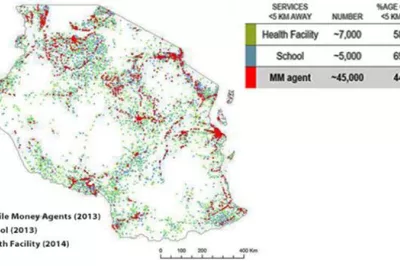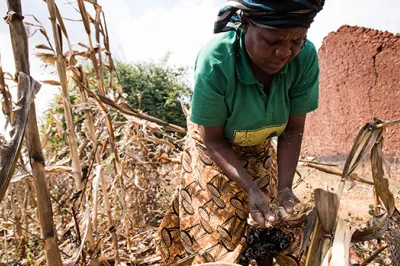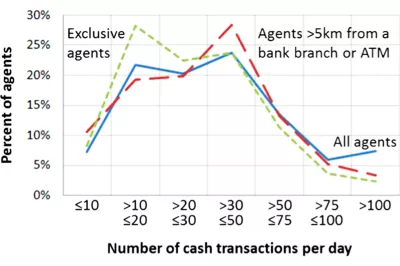Why Distributing Mobile Money Is Harder than Airtime for MNOs
It’s often said mobile network operators (MNOs) have the advantage over banks in creating agent networks from their dense carpet of prepaid airtime sellers. But is this true?
As we first blogged about last year, MNOs outsource much of their airtime distribution to multiple layers of wholesalers and dealers. Do they really have much of a connection to the last mile shop owner to be able to convert him or her into a mobile money agent? One might argue their wholesalers have the connection, but what if they balk at pushing mobile money for the MNO? This isn’t so far-fetched: a shrewd airtime wholesaler might intuit that mobile money could eventually cut them out of the picture entirely, if MNOs gain the capacity for direct sales to consumers. The virtual sales channel would kill the physical one. (This is part of why M-PESA took so long to take off in Tanzania, for example.)
And even where existing airtime wholesalers are willing to help, it’s obvious that convincing merchants to distribute mobile money is very different than airtime, which we’ve talked about in CGAP’s recently published Agent Management Toolkit. The amount of capital can be much greater: the average M-PESA agent in CGAP’s field research held USD 1200 in combined cash and e-float, nearly 10x more than the typical stock of airtime scratch cards (USD 129). Payment operates differently, too: a merchant recoups their airtime investment plus a margin as soon as they sell a scratch card, but often waits to month end to receive mobile money commissions. Even the time per transaction is dramatically different: a few seconds for scratch card and cash to change hands versus typically one minute to complete a mobile money transaction (and longer if networks are clogged). Also, being an effective agent for most mobile money implementations requires more advanced skills in selling, training and customer care than is required to sell a scratch card.
So converting an airtime distribution chain is not the same as flicking a light switch on. Unlike 2009 and even 2010, we’re now seeing MNOs put some money, muscle and thought into crafting their agent networks.
But we see radically different approaches unfolding. We can separate them into 3 categories: totally integrated into airtime distribution, bespoke management, a hybrid.
Total Integration: On a recent trip to West Africa we saw one MNO which intends to completely leverage its airtime sales channel, using the same staff and wholesalers. Staff will now be responsible for both hitting airtime sales targets and will have a new set of KPIs for working with wholesalers’ street-level staff to sign up and manage mobile money agents. It’s too early to tell if this will work. It might, if only because this MNO has its own staff deeply embedded several layers down into the airtime distribution chain. However, the MNO will need to invest in additional training and perhaps consider incentives to motivate staff to take on this extra workload. This wouldn’t work well where a MNO takes a very hands-off approach to airtime distribution (which some have done).
Bespoke Management: The integration approach represents a 180 shift from what until recently was held up as the gold standard in mobile money agent management: M-PESA (Kenya). Safaricom established a parallel, separately staffed and separately incentivized structure for managing its M-PESA agents, entering into a contract with a third party – Top Image – to help vet, train and monitor agents using a veritable army of more than 100 street level staff. Unlike the other two models, many M-PESA agents are not affiliated to the Safaricom airtime business at all. Later, this role became split across several companies like Top Image as well as entrepreneurial types who created networks of sub-agents. While having partners who are totally dedicated to mobile money conveys certain advantages – commitment and attention to the job being the most obvious – it is costly. The expense is hard to bear unless mobile money receives a massive response from consumers, as was the case in Kenya.
Hybrid: Finally, just recently we visited a South Asian MNO who seems to be successfully integrating the two approaches. They leverage their sales staff on the airtime side, adding new KPIs around convincing wholesalers and last-mile agents to take on mobile money. However, they are adding about 50% new staff to ensure there is adequate capacity for staff to handle both the airtime and mobile money channels. In parallel, each region has a dedicated mobile money distribution specialist who works closely with sales staff, and has overall responsibility for how mobile money performs in the region.
In practice, an MNO’s distribution network is only a latent advantage. It still takes a lot of work to convert it into an actual asset in mobile money.




Comments
I think this article shows
I think this article shows two things. 1 A lot of ignorance about West African retail distribution patterns and 2. ignorance about MNO objectives in Mobile Money.
West African retail distribution is not the same as in East Africa. The most successful business models were built on existing retail channels and that is what the most successful West African MNOs did. Ask Tigo and MTN. MTN Uganda also did not use their retail channel because the regions are different but it does not mean West African OPCOS will follow the East African Model to succeed. Ultimately it is not about the agents but the merchants and the merchants are in retail distribution.
Orange in Kenya is taking the back seat and allowing Equity to drive the bus as they are content with churn reduction and airtime sales. Those are higher order benefits for MNOs retaining subscribers and increasing ARPU is the end-game. MM is a means to an end
Add new comment